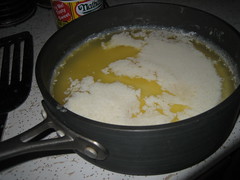 You probably don't like to think about bacteria and food. After all, if you've ever opened up a container of food and smelled an unpleasant aroma emanating from it, you've experienced bacterial growth in action. However, bacteria are responsible for giving us some of our most delicious foods - among them,chocolate, cheese, yogurt, bread, and alcoholic beverages.
You probably don't like to think about bacteria and food. After all, if you've ever opened up a container of food and smelled an unpleasant aroma emanating from it, you've experienced bacterial growth in action. However, bacteria are responsible for giving us some of our most delicious foods - among them,chocolate, cheese, yogurt, bread, and alcoholic beverages. The main type of bacteria that you can thank for this wonder is lactobacillus. We have a fairly symbiotic relationship with lactobacillus. There's some living in your gut right now. This is why pro-biotics can help with digestion. Lactobacillus breaks down sugars that we are unable to digest - sugars like lactose, from which its name is derived.
Of course, lactobacillus is inherently tied to dairy. One species or another is responsible for most most fermented dairy products - cheese, sour cream, creme fraiche, and yogurt are all different varieties of lactobacilli. Lactobacillus is also present in sourdough, where it exists in symbiosis with yeast. Lactobacillus works so well because it produces lactic acid as a byproduct. Most bacteria don't survive well in an acidic environment, and so they are unable to form colonies. Yeast is a rare bacteria that does fare well, which is how it is able to co-exist so happily with lactobacillus.
If you have a mother culture, it is pretty easy to keep it going. In the case of commercial strains of lactobacillus, these strains are easily obtainable. In the case of creme fraiche, simply add a splash of buttermilk to heavy cream, leave it in a warm place until thickened, and pour off the liquid that has separated out.

Yogurt is also ridiculously simple to make. Scald some milk, let it cool to the point where it is hot, but not burning you, and whisk in some yogurt.

Let it sit in a warm place (if you have a warming drawer in your oven, this works great; there are also commercial yogurt makers) until it thickens, then pour off the liquid that has separated. Now you have yogurt that costs about half or less what you would have paid for it at the grocery store.
Furthermore, if you then take that yogurt, put it in cheesecloth, and hang it for an hour or two, you'll be left with yogurt cheese, a thick, creamy spreadable substance, that, when mixed with herbs and drizzled with olive oil, yields a wonderful spread for sandwiches, or just plain enjoying on pita.




I've never made my own yogurt, but have friends who swear by it. Thanks for making it look so easy for those of us still intimidated by it.
ReplyDeleteSuch a fascinating post! It’s amazing how the same bacteria we often fear can also be the source of so many nutritious and flavorful foods. Probiotic-rich options like yogurt and fermented foods are something the best nutritionist in Borivali Mumbai - Dt. Foram Modi often recommends for better gut health and digestion!
ReplyDelete